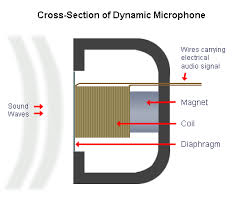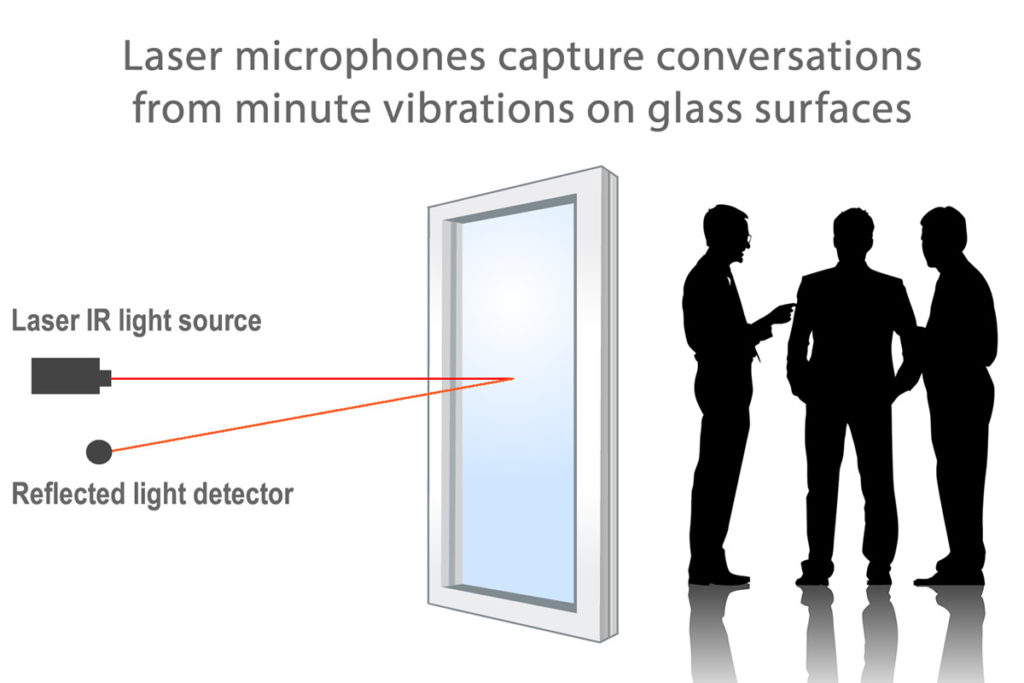(1) Dynamic Microphones — By far the most common type of handheld/stand microphones used in live situations and sometimes even in recording. They are very rugged, least expensive of all types, have great feedback rejection and some of them produce very natural, uncolored and warm sound. They can handle very loud voices (high SPL) and are unaffected by indoor climatic conditions.
These microphones have a thin diaphragm that moves in response to sound pressure created when we speak into them. The diaphragm’s movement causes a voice coil suspended in a magnetic field to move. This generates a small electric current that is called Microphone level signal. Microphone level signal output (sensitivity) varies between high to low depending on make and model of microphone. Microphones with low impedance (resistance), ones that have less than 600 ohms should only be used. Fortunately most new microphones have low impedance (between 200-300 ohms range) so this may not be an issue when using long microphone cables. Dynamic microphones do not need phantom power to operate. There are some exceptions like enCore 200 that need phantom power. Turning phantom power on or off will not damage or effect a dynamic microphone.

Ruggedness comes with a price. Since they are very mechanical, most of them lack the transient response of condensers and do not capture the details (not very crisp) as good as condenser or ribbon microphones. Dynamics have more mellow and rounded sound. Remember this is very important for us because this can misrepresent Tajweed to a very large extent especially when recording Qiraat. There are some letters in Arabic language that are very close in pronunciation and we want a microphone that can bring these differences out clearly. Every letter in Quran has to be given its due weight. This is Tarteel. The dynamic microphones that we are recommending have very good transient response in their class.
Transient Response: A microphones ability to respond to rapidly changing sound wave. A sports car (condenser mic) responds to traffic changes much quicker than a 18 wheeler (dynamic mic). Examples include Shure SM58, AKG D5, Audix OM3, Sennheiser e935 etc.
(2) Condenser Microphones — Most commonly found in recording studio and these days even in controlled live situations. This is a mechanical microphone with almost no moving parts. It basically has a thin diaphragm stretched against a metal backplate. This basically becomes a capacitor and is given an electrical charge using phantom power on the mixer or preamp.

When we speak into these mic, the diaphragm vibrates very lightly against the backplate creating difference in voltage output from this so called capacitor. This signal is the microphone level signal that goes down the microphone cable and is again referred to as Microphone Level signal. Depending on size of diaphragm they can be small diaphragm, medium diaphragm and large diaphragm condensers.
Condensers have very high level of Microphone Level signal output (hotter mics). These microphones especially the large diaphragm ones are used in recording Qiraat in studios. In live situations they are commonly used for musical instruments because of their quick transient response. They have limited application as a handheld/stand microphone is a Masjid setup. Condensers that are used in a Masjid setup include lavaliers, headset, shotgun, coir and boundary / floor mics. In terms of size they happen to be the biggest and the smallest microphones and of every size in between. Examples include Rode NT5, Shure KSM32, AKG 414 XL II, Neumann U87 / M149 etc.
(3) Ribbon Microphones — A ribbon microphone is basically a type of dynamic microphone that uses a thin aluminum (or similar metal) ribbon placed between the poles of a magnet to generate voltages by electromagnetic induction.

A voltage is induced at right angles to both the ribbon velocity and magnetic field direction. As the sound wave causes the ribbon to move back and forth, the induced voltage in the ribbon is proportional to the particle velocity in the sound wave. The voltage output of most ribbon microphones is typically quite low compared to a dynamic moving coil microphone and a step-up transformer is used to increase the voltage output and increase the output impedance.
Ribbon microphones are typically bidirectional, meaning they pick up sounds equally well from either side of the microphone. They are prized for their ability to capture high-frequency detail, comparing very favorably with condenser microphones, which can often sound subjectively “aggressive” or “brittle” in the high end of the frequency spectrum. The Microphone level output of ribbon microphones is very low and hence need a big gain levels at the mixer or preamp stage. These microphones can also be used in recording Qiraat as they produce very warm clear vocals without any harshness. Some newer ribbon microphones are active (meaning they use phantom power) and have high output like condenser microphones. Examples : RCA-77, Royer 121 / 122 etc.
(4) Laser Microphones — Laser microphone uses a laser beam to detect sound vibrations in distant objects. The object is typically inside a room where a conversation is taking place, and can be anything that can vibrate (window glass, a picture on a wall etc) in response to the pressure waves created by noises present in the room. The object preferably has a smooth surface. The laser beam is directed into the room through a window, reflects off the object and returns to a receiver that converts the beam to an audio signal. The minute differences in the distance traveled by the light as it reflects from the vibrating object are detected interferometrically. The interferometer converts the variations to intensity variations, and electronics are used to convert these variations to signals that can be converted back to sound.

A new laser microphone uses a laser beam and smoke or vapor to detect sound vibrations in free air. Particulate Flow Detection Microphone is based on a laser-photocell pair with a moving stream of smoke or vapor in the laser beam’s path. Sound pressure waves cause disturbances in the smoke that in turn cause variations in the amount of laser light reaching the photo detector. Basically using a laser microphone you can now hear anybody who is miles away.
(5) Others – There are other microphones that can be part of these types including Carbon Microphones, Crystal Microphones, Fiber Optic Microphones, Liquid Microphones, MEMS Microphone, Speakers as Microphones etc. Because these types are not commonly used in a Masjid setup, we am not writing anything about them.

